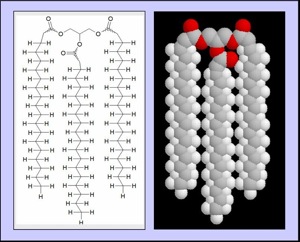
- cells and molecules home
- carbohydrates
- proteins
- fats
- vitamins
- minerals
- electrolytes
- water
- nucleic acids
- gases
Section Links
Fats (Lipids)
What are Fats?
Fats are important macromolecules which are relatively insoluble in water. The most important types of fats are triglycerides, phospholipids, and steroids. Triglycerides have three fatty acid tails attached to a glycerol backbone. Membrane fats are called phospholipids due to their modification with a negative phosphate group. Steroids such as cholesterol are quite differently shaped that fatty acids, but are classified as lpids due to their insolubility.
Types of Fat
Fat structure is determined by length, degree of saturation, and the position of the first double bond.

Mono- and Polyunsaturated Fats
Monounsaturated fats are ok but not as good as the polys. Polyunsaturated fatty acids (PUFA) contain more than one double bond. Some PUFAs appear strongly beneficial in heart disease and perhaps other conditions (ref). The more unsaturated fats in your cells, the more pliable and dynamic their membranes are.
omega-3 fatty acids suppress cardiac arrhythmias, lower serum TAG, reduce thrombosis, and substantially reduce the risk of cardiovascular mortality. However, they do not appear to lower LDL or increase HDL in people.
- α-linolenic acid (ALA) is found in plants such as flax, soybean, and others
- docosahexaenoic acid (DHA) and eicosapentaenoic acid (EPA) are found in fish oils
- omega-3 derived eicosanoids are less active and antiaggregatory
omega-6 fatty acids
- linoleic acid
- gamma-linolenic acid
- arachidonic acid and eicosanoids
Saturated Fats
Saturated fats primarily come from animal sources and can have troubling health effects. They have two hydrogen atoms for each carbon in their tails, allowing them to pack closely together and leading to their solidity at room temperature.
Trans Fats
Trans fats are unsaturated fats which have been chemically modified to give them a longer shelf life, improve their taste and consistency, and increase their stability while cooking. However, this modification has serious health risks, with almost 30% of heart disease in the developed world appearing to be caused by trans fats (Mozaffarian et al, NEJM 2006). Further information on trans fats can be found here.
Cholesterol
Cholesterol is a key molecule in our body, forming the framwork for many of our hormones and playing a key role in keeping our cells flexible. It can also be a troublesome molecule. In situations of dyslipidemia, cholesterol can accumulate on blood vessel walls and contribute to atherosclerosis. HDL and LDL are transport carriers for cholesterol in the blood.
Fat in the Diet
Fat intake is an important consideration in nutrition. Lipids are the primary source of energy for all tissues (save the brain between meals) and play an important role in energy storage as fat.
Adults eat between 60-150g of lipids/day, 90% of which is TAG. The rest is cholesterol, phospholipids, and free (unesterified) fatty acids.
Further details coming soon...
Fats in the Body
Important fat derivates include the eicosanoids, precursors of prostaglandins, leukotrienes, and thromboxanes.
Fats are also used as precursors for various hormones.
Doctors think each day about fatty acid metabolism.
After a meal, chylomicrons containing TAG and apo C-II are acted upon by lipoprotein lipase, located in the capillaries of muscle and adipose tissue and activated by insulin. FFAs can be taken up directly or transported on albumin.
Lipid digestion occurs throughout the GI tract, with the bulk occurring in the small intestine. Lipid uptake is mediated by bile.
Lipid absorption first occurs in the small intestine, followed by transport and processing in the liver.
Lipid transport in the circulation is mediated by lipoproteins such as HDL and LDL.
Lipid degradation for use in energy occurs through beta-oxidation. Ketone bodies can result.
Fatty acid synthesis and TAG synthesis occur in some places.
Steroids alter fatty acid metabolism by preventing phospholipase A2 activity
Because lipids are hydrophobic, they tend to be compartmentalized within the body, in cell membranes, as droplets of TAG inside adipocytes, and associated with protein (ie lipoproteins) during plasma transport.
Because lipids are hydrophobic, various strategies assist their solublization in water. Lipids tend to associate with each other in body compartments, in cell membranes, as droplets of TAG inside adipocytes, and associated with lipoproteins during plasma transport. Lipid surface area is increased by breaking them down to facilitate their interaction with amphipathic molecules, such as bile, and enzymes. Large hydrophobic molecules are degraded into their smallest units for transport into cells. Large lipid particles are transported in stabilized particles, while small hydrophobic molecules are bound to hydrophilic proteins inside cells (ie fatty acid binding proteins) and in blood (albumin).
Fat as Fuel
One gram of fat produces 9 calories when oxidized, more than any other molecule.
During fasting, proteins are used as an energy source following glycogen depletion, generating carbon skeletons following deamination that can be used at various points in the TCA Cycle.
Levels of total urinary nitrogen, a measure of deamination, peak early during fasting and fall of during the proceeding weeks. In order to maintain levels, TAG stores are therefore mobilized .
In the fat, insulin and epinephrine activates hormone-sensitive lipase via cAMP and PKA, liberating FFAs and glycerol to the blood.
Glycerol cannot be phosphorylated in adipose tissue, and so it must return to the liver to be metabolized.
Fats in Disease
Dyslipidemias can be caused by defects in lipases, apo proteins, their receptors, or other causes.
Atherosclerosis results from the accumulation of lipids in blood vessel walls, leading to angina, acute coronary syndromes, renal disease, strokes, peripheral vascular disease, and other serious health threats.